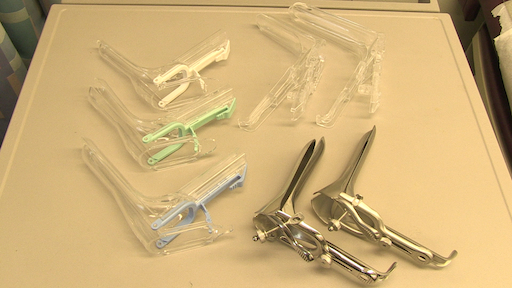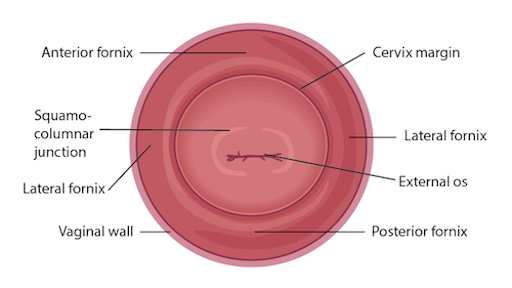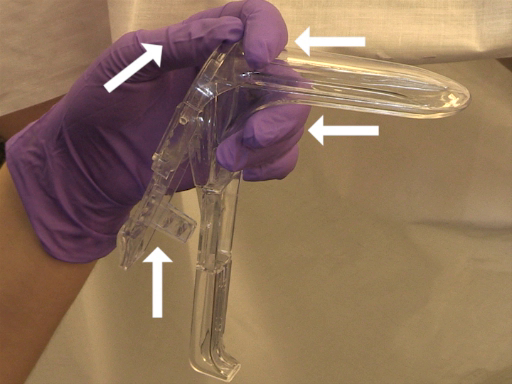Examen pelvien: Examen au spéculum
Vue d'ensemble
Source :
Alexandra Duncan, GTA, Praxis clinique, New Haven, CT.
Tiffany Cook, GTA, Praxis clinique, New Haven, CT.
Jaideep S. tari, MD, médecine interne et pédiatrie, école de médecine de Yale, New Haven, CT.
Placement de spéculum confortable est une compétence importante pour les fournisseurs à se développer, étant donné que le spéculum est un outil nécessaire pour nombreuses interventions gynécologiques. Les patients et les fournisseurs sont souvent inquiets de l’examen de spéculum, mais il est tout à fait possible de placer un spéculum sans inconfort pour le patient. Il est important pour le clinicien de connaître le rôle joué par langue en créant un environnement confortable ; par exemple, un fournisseur doit désigner le spéculum « bills » au lieu de « lames » d’éviter de perturber le patient.
Il existe deux types de spéculums : métal et plastique (Figure 1). Cette démonstration utilise en plastique, comme les spéculums en plastique sont plus couramment utilisés dans les cliniques pour les tests de routine. Lorsque vous utilisez un spéculum en métal, il est recommandé d’utiliser un spéculum Graves si le patient a accouché par voie vaginale et un spéculum Pederson, si le patient n’a pas. Spéculums Pederson et tombes sont de différentes formes, et les deux viennent dans beaucoup de différentes tailles (moyenne est utilisée le plus souvent). Avant de placer un spéculum en métal, il est utile d’effectuer un examen du col utérin digital pour évaluer la taille du spéculum approprié. La profondeur et la direction du col de l’utérus est estimée en plaçant un doigt dans le vagin. Si le col de l’utérus de la patiente peut être trouvée, alors que le patient est assis, il est probable que le patient a un vagin peu profond et qu’il devrait donc être plus à l’aise avec un spéculum métallique court.

La figure 1. Une photographie de spéculums commercialement disponibles dans différentes tailles.
Spéculums en plastique sont en forme de Pederson spéculums en métal et viennent dans différentes tailles. Afin d’évaluer la taille appropriée pour un spéculum en plastique, l’examinateur met deux doigts dans le vagin de la patiente, paume vers le bas et tente de séparer les doigts : s’il n’y a pas d’espace entre les doigts, un petit spéculum en plastique doit être utilisé ; s’il y a l’espace entre les doigts, un milieu un devrait être utilisé. L’examen ne devrait s’effectuera avec un gros spéculum (tel qu’il est beaucoup plus longue) sans d’abord déterminer la longueur du canal vaginal.
Le spéculum est utilisé pour effectuer le test de Papanicolaou dans le cadre des examens de dépistage du cancer du col utérin. Cancer du col utérin était autrefois la principale cause de décès par cancer chez les femmes aux États-Unis, mais dans les dernières décennies le nombre de cas et de décès a diminué de façon significative1. Ce changement est crédité de la découverte faite par Georgios Papanicolaou en 1928 que cancer du col utérin peut être diagnostiqué par frottis vaginales et cervicales. Le test de Papanicolaou, comme on l’appelle maintenant, détecte des cellules anormales dans le col de l’utérus, cancéreuse et précancéreuse. Les lignes directrices actuelles pour des intervalles de dépistage recommandé se trouvent dans le site Web de U.S. Preventive Services Task Force (USPSTF)2.
Le test peut être effectué à l’aide soit 1) une lame de verre classiques et fixateur avec un pinceau spatule et endocervical (le traditionnel « frottis ») ou 2) le plus couramment utilisé de cytologie liquide avec un balai cervical ou un pinceau spatule et endocervicales (Figure 2). N’importe quels outils sont utilisés, les échantillons sont prélevés à l’intérieur de l’orifice externe et la jonction pavimento-cylindrique ou la zone de transition autour de l’os (Figure 3). Cette vidéo montre la spatule et brosse endocervicale avec cytologie liquide, comme la préparation liquide est une technique plus efficace pour la détection des lésions cervicales et la brosse spatule et endocervicales améliorer PRELEVEMENT.

Figure 2. Outils de test de PAP. Montré dans la séquence sont : un traîneau de cytologie liquide cervical balai, spatule et brosse endocervicale.

Figure 3. Diagramme du col de l’utérus avecstructures concernées étiquetés.
Procédure
L’examen spéculum commence immédiatement après la fin de l’examen des organes génitaux externes ; par conséquent, le patient a fourni une histoire déjà et est en position gynécologique. Assurez-vous que le patient est assis à la fin de la table, car le spéculum ne peut être inséré complètement autrement.
1. préparation
- Disposez les fournitures pour le test de Pap.
- Étiqueter le contenant de la cytologie liquide avec information du patient.
- Dévissez le couvercle d
Applications et Résumé
Cette vidéo a examiné les techniques pour effectuer un examen spéculum confortable et la collecte des échantillons pour un test de Pap. Avant l’examen, l’examinateur doit s’assurer toutes les fournitures sont préparés et laisser le patient sait à quoi s’attendre. Être en mesure d’effectuer un examen spéculum confortable est une compétence importante pour tout praticien, car il est utilisé dans une grande variété de procédures gynécologiques et peut fournir une mine de renseignements. Quand le sp?...
References
- Cervical Cancer Statistics. U.S. Preventive Services Task Force. Centers for Disease Control and Prevention (2014).
- Cervical Cancer: Screening. Recommendation Summary. U.S. Preventive Services Task Force (2012).
- Wright, D., Fenwick, J., Stephenson, P., Monterosso, L. Speculum 'self-insertion': a pilot study. Journal of Clinical Nursing. 14(9): 1098-1111 (2005).
Tags
Passer à...
Vidéos de cette collection:

Now Playing
Examen pelvien: Examen au spéculum
Physical Examinations II
150.3K Vues

Examen des yeux
Physical Examinations II
77.1K Vues

Examen ophtalmologique
Physical Examinations II
67.9K Vues

Examen des oreilles
Physical Examinations II
55.1K Vues

Examen du nez, des sinus, de la cavité orale et du pharynx
Physical Examinations II
65.7K Vues

Examen de la thyroïde
Physical Examinations II
105.0K Vues

Examen des ganglions lymphatiques
Physical Examinations II
387.2K Vues

Examen abdominal I: Inspection et auscultation
Physical Examinations II
202.6K Vues

Examen abdominal II: Percussion
Physical Examinations II
248.1K Vues

Examen abdominal III: Palpation
Physical Examinations II
138.5K Vues

Examen abdominal IV: Évaluation de la douleur abdominale aiguë
Physical Examinations II
67.3K Vues

Toucher rectal chez l'homme
Physical Examinations II
114.4K Vues

Examen général des seins
Physical Examinations II
87.6K Vues

Examen pelvien I: Évaluation des organes génitaux externes
Physical Examinations II
306.8K Vues

Examen pelvien III: Examen bi-manuel et toucher rectal
Physical Examinations II
147.7K Vues
